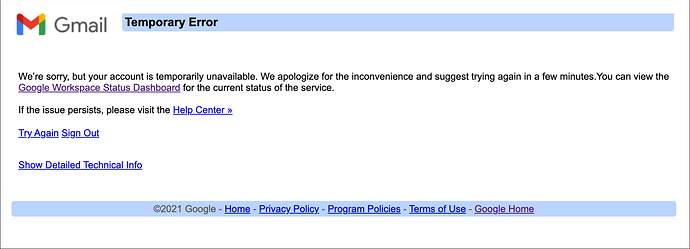At the risk of beating the same drum again, I just want to reiterate my concern for anyone who uses an “@gmail” with your primary email.
Now, this could also be true with “@icloud” or “@some company name here” but since Gmail is the 8,000-pound gorilla in the room, and since I have first-hand experience with problems with Gmail, I want to raise the warning flag to others.
I still use my @gmail account, usually for anywhere that demands my email address but I don’t fully trust with my email address. So it tends to get cluttered with junk.
I decided to try to clean it out and make sure that the occasional important email (receipts, software licenses, etc) are easy to find.
So I spent a few hours last night deleting and sorting, deleting and sorting. I did this using Gmail in Google Chrome on my Mac.
Then I got this error:
When I clicked on the “Show Detailed Technical Info” it said “Numeric Code: 2”
When I googled for “gmail temporarily unavailable numeric code 2” there are a whole host of other people who have run into this same issue, with no real explanation of why, other than “Some algorithm at Google decided to temporarily lock you out of your own Gmail account, and now you need to wait to be allowed back in.”
How long? No one knows. Minutes? Hours? Days?
Will it happen again? Possibly.
If it happens multiple times are you risking getting locked out for longer? Maybe!
It was long enough that I lost the ‘groove’ that I was in, and decided to go to bed.
Since I was only about 1/3rd of the way through my email, I’ve been working on it again today (relieved that I was allowed back in), and trying to take more breaks, in the hope that whatever secret monitoring system Google is using won’t decide to lock me out of my account again before I finish.
(I suppose I could have avoided this by just letting all of my email pile up and paying Google for more space, but that isn’t what I wanted to do.)
The point here isn’t to debate whether or not we agree with this policy that Google has in place. I’m sure some could argue that it’s some kind of protection (although my account is already protected by a long random password and two-factor authentication, and I was logged in from my home I.P. address).
That’s not the point, and any debate that we might have about it is beside the point.
What is the point is that Google has the ultimate authority to decide if it wants to lock me out of my Gmail account, and there is 100% nothing that I could do about it. Yes, in this case it came back and I was able to access it again the next day, but I now have to modulate my behavior to try not to trip up some secret algorithm. (It’s not like someone at Google was sitting there deciding “I think something is up here, I’m going to block this account.” I’m 100% sure it was all automated. But it’s also 100% not documented and not clear what the limits are.)
Fortunately, this account is just many GB of mostly junk email for me, and I have a local backup via Horcrux anyway.
But it’s another reminder that if your email address that links to your online life (banking, credit cards, etc) is in the hands of someone else, especially if that someone else is Google, you better know the risks. Who would you turn to for help? Who could you contact for support? Are you a paying customer?
If you own your email domain, the worst that can happen is that you have to move it from one provider to another, but you’ll still have access to your same email address. If you have backups of your email, you can move it to a different email provider.
Just don’t put all of your eggs in someone else’s basket.




